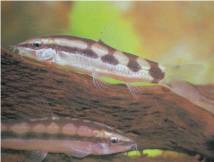Dwarf Loach
Genus name: Botia Sidthimunki
Also known as: Chained Loach, Ladderback Loach, Pygmy Loach, Chain Botia
Distribution: Thailand
Length: up to 1.4″ (3.5cm)
Minimum Tank Length: 12″ (30cm)
Water Temperature: 77-86F (25-30C)
Diet: Worms, crustaceans, insects, plant matter, dried food
Water: soft water required
Lives: mostly in the middle layers
Breeding: Egg Layers
The Dwarf Loach was thought until recently to be extinct in the wild, but it was recently re-discovered in Thailand. It has been bred in captivity for the home aquarium market since it was discovered in 1959.
The Dwarf Loach has a brownish back, and a silvery-white abdomen. The flanks are golden-brown with a very variable pattern of dark brown markings arranged in four longitudinal bands. These bands are connected to one another by similarly coloured transverse bars, giving an almost netlike appearance. When Dwarf Loaches are young the dark markings are almost black.
Dwarf Loaches are active by day and night. They can be kept in a small shoal of at least three, but ideally five, other Dwarf Loaches. There should be a number of rocks and roots arranged in the aquarium to form suitable hiding places, and at least one quarter of the water should be changed every month.
The Dwarf Loach has spines in front of its eyes, and these are raised when the fish is excited or feels threatened. These spines may get caught up in the mesh of the net when the fish is being moved from one aquarium to another. It is very important to disentangle the Dwarf Loach from the net very carefully so as not to damage them. Also, great care should be taken to avoid the sharp spines on the Dwarf Loach, as they can cause painful wounds to the hands.
Dwarf Loach do not generally breed in home aquariums.

